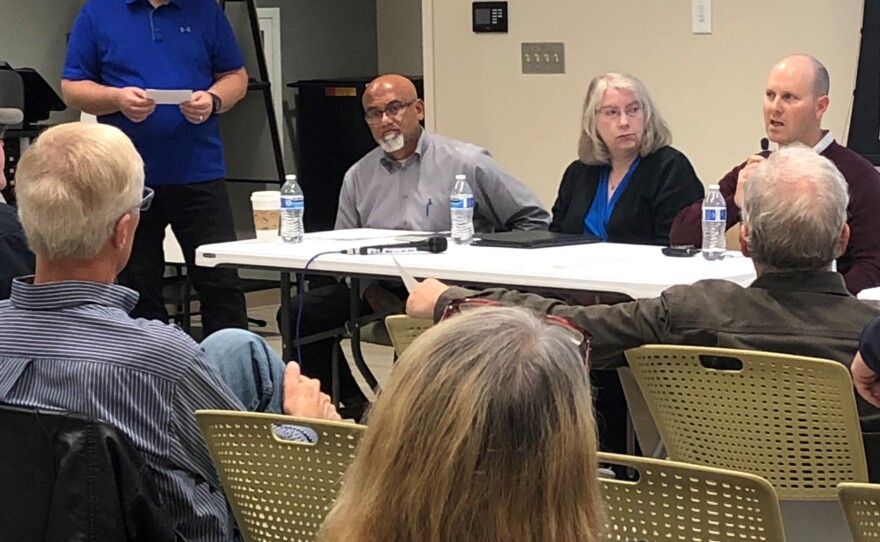EPA scientists say the death rate in the Fairbanks North Star Borough has fallen because citizens are working to clean the air. That was announced among other progress at an Air Quality presentation in North Pole this week. A community meeting featured panelists from the EPA, the state and the borough, who took questions from the audience.
The panel reviewed some of the 10-year-long journey of government oversight of Fairbanks and North Pole’s pollution problem, then mentioned new regulations, new science and new health data. Krishna Viswanathan from the Environmental Protection Agency mentioned a yet-unreleased study using BenMAP that showed fewer people dying from air-pollution.
“From 2015 to 2018, the initial look at what we’ve found is that there is a reduction in mortality rates in this area with data from this community.”
He says the data are preliminary, and sources need to be confirmed before the study is official. But he says, there is a solid correlation between air pollution and dying. The death rate has dropped "in the double digits," he said. That means at least 10 lives were saved from reduced pollution between 2015 and 2018. EPA Researcher Nicole Briggs will look at epidemiological study to sort out factors like genetic cancers and smoking in pollution-related deaths in Fairbanks and North Pole.
Viswanathan said the low death numbers are because of several factors – citizens burning only dry wood, or choosing not to burn wood, or because the winters have been milder with fewer inversions to trap air in the Tanana Valley.
Alice Edwards from the Alaska Department of Environmental Conservation gave a status report on the Serious State Implementation Plan, or SIP. That is the long list of instructions and recommendations compiled by DEC. Among the draft regs are better woodstove tech, more burn ban days, and changing from Number 2 Diesel fuel to the much cleaner-burning but more expensive Number 1 heating fuel.
“Purely from a statutory perspective, we have requirements we need to meet as a state, or we face consequences. Those consequences are not just sanctions, but also consequences to the community and to the quality of life here.”
The SIP is still a draft and the Department just posted on its website all the comments it received this summer on the proposed regulations. That DEC website is also where you can see graphs of local air-quality monitors. Edwards says voluntary programs are working.
“This is a real collective effort. We need everybody’s help to get there.”
The graph from the air quality monitor for downtown Fairbanks shows little change over the last 18 years – with the PM2.5 concentration hovering up to 50 and last year, down to 35 – that’s below the National Ambient Air Quality Standard maximum for that particulate.
The graph for North Pole, however, is pretty impressive; and shows a constant downward line since it was installed on Hurst Road in 2012, when it measured 158. Still way above the national standard for PM2.5, it has dropped to last year’s 52.

After the panel discussion, many folks still had questions about the regulations in the SIP, Natural Gas accessibility and Electrostatic Presipitators – the smoke-scrubbing chimney appliances called ESPs.
Nick Czarnecki, the borough’s Air Quality Manager, says citizens are working more closely with agencies to report data from their private air monitors and get advice about personal action to reduce pollution.
“There’s a lot of collaborative work going on, issues like the ESP; that takes borough, state and EPA involvement, and I’ve got the non-profit Smoke Busters, with Mike here.”
That Mike would be Mike Prax, who is active in spreading the gospel of ESPs, a strategy he likes much better that state regulations on the estimated 14,000 woodstoves in the borough.
“If we are concerned about cleaning up the air, we need to help our neighbor, rather than criticize our neighbor or force our neighbor.”
The borough has contracted with a C0nnecticut company, ClearStak, to test the effectiveness of Electrostative Precipitators and other chimney-scrubbers this winter. If they prove to be effective, ESPs could be a measure added to the State Implementation Plan. And that could open the door to possible federal funding for citizens installing ESPs on their woodstove chimneys.
Former Borough Assembly member and North Pole resident Hank Bartos, says he lives in the "Triangle of Death."
“I changed out an outdoor wood boiler, and I went through the borough program, and changed it out for a gas-fired boiler. I’m a senior citizen, I’m in the most vulnerable group in the most vulnerable area, and I want to see the air cleaned up.”




